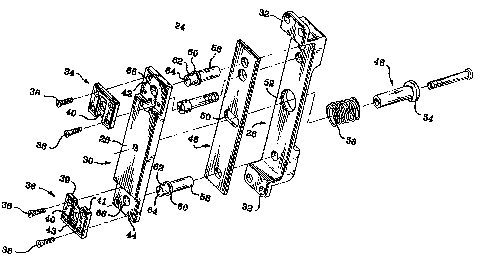Some of the information on this Web page has been provided by external sources. The Government of Canada is not responsible for the accuracy, reliability or currency of the information supplied by external sources. Users wishing to rely upon this information should consult directly with the source of the information. Content provided by external sources is not subject to official languages, privacy and accessibility requirements.
Any discrepancies in the text and image of the Claims and Abstract are due to differing posting times. Text of the Claims and Abstract are posted:
| (12) Patent: | (11) CA 2136005 |
|---|---|
| (54) English Title: | ELECTROMAGNETIC DOOR LOCK ARMATURE ASSEMBLY |
| (54) French Title: | ARMATURE DE SERRURE DE PORTE ELECTROMAGNETIQUE |
| Status: | Expired and beyond the Period of Reversal |
| (51) International Patent Classification (IPC): |
|
|---|---|
| (72) Inventors : |
|
| (73) Owners : |
|
| (71) Applicants : |
|
| (74) Agent: | NORTON ROSE FULBRIGHT CANADA LLP/S.E.N.C.R.L., S.R.L. |
| (74) Associate agent: | |
| (45) Issued: | 2002-06-04 |
| (86) PCT Filing Date: | 1992-10-27 |
| (87) Open to Public Inspection: | 1994-02-17 |
| Examination requested: | 1999-09-08 |
| Availability of licence: | N/A |
| Dedicated to the Public: | N/A |
| (25) Language of filing: | English |
| Patent Cooperation Treaty (PCT): | Yes |
|---|---|
| (86) PCT Filing Number: | PCT/US1992/009361 |
| (87) International Publication Number: | US1992009361 |
| (85) National Entry: | 1994-11-16 |
| (30) Application Priority Data: | ||||||
|---|---|---|---|---|---|---|
|
An electromagnetic door lock assembly employs an electromagnet (10) positioned
in a frame adjacent to a door, and an ad-
justable armature assembly positioned in the door for interaction with the
electromagnet. The armature assembly (24) includes an
armature plate (28) having a pair of shear low-cost, replaceable elements that
initially engage the electromagnet (10). A backing
plate (46) is situated adjacent to the armature plate, and a stem coupling the
backing plate to the armature plate includes a spring
biasing the backing plate (46) and armature plate (28) toward each other. A
mounting portion for mounting the armature assem-
bly (24) to a door to be locked is provided with adjusting screws for
adjustably positioning the backing plate at a fixed position
with respect to the mounting portion so that the armature plate (28) is
positioned at a first position for optimum interaction with
the electromagnet (10), the screws having elongated heads for maintaining the
relative alignment between the armature plate (28)
and the mounting portion as the armature plate moves between the first
position and a position contiguous to the electromagnet
(10).
Note: Claims are shown in the official language in which they were submitted.
Note: Descriptions are shown in the official language in which they were submitted.

2024-08-01:As part of the Next Generation Patents (NGP) transition, the Canadian Patents Database (CPD) now contains a more detailed Event History, which replicates the Event Log of our new back-office solution.
Please note that "Inactive:" events refers to events no longer in use in our new back-office solution.
For a clearer understanding of the status of the application/patent presented on this page, the site Disclaimer , as well as the definitions for Patent , Event History , Maintenance Fee and Payment History should be consulted.
| Description | Date |
|---|---|
| Time Limit for Reversal Expired | 2004-10-27 |
| Letter Sent | 2003-10-27 |
| Grant by Issuance | 2002-06-04 |
| Inactive: Cover page published | 2002-06-03 |
| Inactive: Final fee received | 2002-03-20 |
| Pre-grant | 2002-03-20 |
| Notice of Allowance is Issued | 2002-01-09 |
| Notice of Allowance is Issued | 2002-01-09 |
| Letter Sent | 2002-01-09 |
| Inactive: Approved for allowance (AFA) | 2001-12-19 |
| Amendment Received - Voluntary Amendment | 1999-12-02 |
| Letter Sent | 1999-10-05 |
| Inactive: Application prosecuted on TS as of Log entry date | 1999-10-04 |
| Inactive: Status info is complete as of Log entry date | 1999-10-04 |
| Request for Examination Requirements Determined Compliant | 1999-09-08 |
| All Requirements for Examination Determined Compliant | 1999-09-08 |
| Application Published (Open to Public Inspection) | 1994-02-17 |
There is no abandonment history.
The last payment was received on 2001-10-05
Note : If the full payment has not been received on or before the date indicated, a further fee may be required which may be one of the following
Patent fees are adjusted on the 1st of January every year. The amounts above are the current amounts if received by December 31 of the current year.
Please refer to the CIPO
Patent Fees
web page to see all current fee amounts.
| Fee Type | Anniversary Year | Due Date | Paid Date |
|---|---|---|---|
| MF (application, 5th anniv.) - standard | 05 | 1997-10-27 | 1997-10-08 |
| MF (application, 6th anniv.) - standard | 06 | 1998-10-27 | 1998-10-14 |
| Request for examination - standard | 1999-09-08 | ||
| MF (application, 7th anniv.) - standard | 07 | 1999-10-27 | 1999-10-15 |
| MF (application, 8th anniv.) - standard | 08 | 2000-10-27 | 2000-10-13 |
| MF (application, 9th anniv.) - standard | 09 | 2001-10-29 | 2001-10-05 |
| Final fee - standard | 2002-03-20 | ||
| MF (patent, 10th anniv.) - standard | 2002-10-28 | 2002-10-03 |
Note: Records showing the ownership history in alphabetical order.
| Current Owners on Record |
|---|
| VON DUPRIN, INC. |
| Past Owners on Record |
|---|
| KEVIN P. WALTZ |